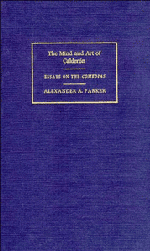Book contents
- Frontmatter
- Contents
- Author's preface
- Editor's preface
- Introduction
- I Stylistic and dramatic craftsmanship
- II From experience to myth
- III The tensions of social life
- IV The tensions of public life
- 18 The king as centre of political life
- 19 Religion and the state: La cisma de Ingalaterra
- 20 The issue of religious freedom
- 21 Religion and war: El príncipe constante
- 22 The drama as commentary on public affairs
- V From symbol to myth
- Epilogue
- Notes
- Index
19 - Religion and the state: La cisma de Ingalaterra
Published online by Cambridge University Press: 05 February 2012
- Frontmatter
- Contents
- Author's preface
- Editor's preface
- Introduction
- I Stylistic and dramatic craftsmanship
- II From experience to myth
- III The tensions of social life
- IV The tensions of public life
- 18 The king as centre of political life
- 19 Religion and the state: La cisma de Ingalaterra
- 20 The issue of religious freedom
- 21 Religion and war: El príncipe constante
- 22 The drama as commentary on public affairs
- V From symbol to myth
- Epilogue
- Notes
- Index
Summary
The reign of Henry VIII is one of the most momentous in English history because of its far-reaching consequences. On the level of Henry's private life, the reign is also one of the most sensational because of his six marriages and the fates of the rejected wives. His first marriage was the cause of the schism from Rome, which led to the English Reformation and the ecclesiastical settlement under his daughter Queen Elizabeth. Henry, who was born in 1491, came to the throne in 1509. He married Catherine of Aragon, the daughter of Ferdinand and Isabella of Spain, in the same year. She was the widow of his elder brother Arthur, who had died in 1502. Doubts had been expressed, even by the Pope, about the validity of Catherine's second marriage to her brother-in-law, since marriage to one's brother's widow could be possibly construed as incestuous. This did not trouble Henry's conscience at the time, but when it became certain twenty years later that he could have no further issue from the marriage than his daughter Mary, Henry alleged the canonical impediment as a reason for divorcing Catherine in order to obtain a male heir. There had been no queen regnant in English history and since Henry's father had won the throne after a long civil war, Henry felt it expedient that Mary's right of accession should not be challenged. He therefore decided to obtain a divorce from Queen Catherine which was only canonically possible if his marriage could be considered invalid.
- Type
- Chapter
- Information
- The Mind and Art of CalderónEssays on the Comedias, pp. 250 - 282Publisher: Cambridge University PressPrint publication year: 1989

